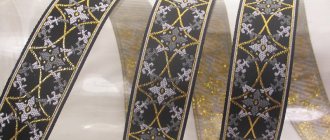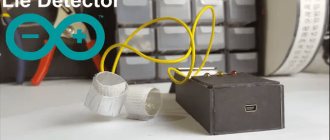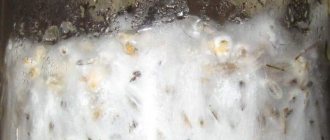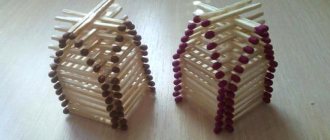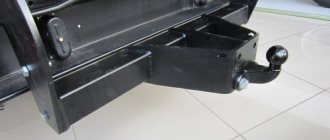HTSChemistry and experiments / Homemade products Magnetic fluid has recently become more popular in online stores. Children love to play with it, although adults also sometimes like to play around with it. That is why we decided to devote this review to making magnetic fluid at home with our own hands. We recommend starting, according to tradition, by watching a video from the author of the idea
What do we need: - vegetable oil; - iron powder; - container - magnets. According to the author of the idea, iron powder can be obtained using a file and a piece of iron. The first step is to pour the iron powder into a container. It is worth noting that the more powder you have, the better, since the properties of the magnetic fluid are fully manifested in large quantities. After this, you need to add just a little vegetable oil. Mix everything thoroughly. It is better to mix with a wooden spoon or a barbecue skewer. After one and a half to two minutes of stirring you will get your magnetic liquid. Note that when using you need to be careful and do not bring the magnet directly to the liquid, as it will stick and you will no longer be able to remove it from the magnet . Therefore, it is recommended to do this through paper, plastic or something else.
Delivery of new homemade products to the post office
Receive a selection of new homemade products by email. No spam, only useful ideas!
*By filling out the form you agree to the processing of personal data
Become the author of the site, publish your own articles, descriptions of homemade products and pay for the text. Read more here.
The theory is this: modern laser printers contain the mineral magnetite (Fe3O4). It is needed so that the paint particles stick to the paper. This mineral reacts to magnetic fields and is thus well suited for our experiment.
The first method of obtaining magnetic fluid:
Almost anyone can make a liquid that reacts to a magnetic field with their own hands - without any reagents and in just a few minutes . Of course, its quality is significantly worse than that obtained chemically. In particular, the consistency of the product is such that it can rather be called not a “liquid”, but a “slurry”. And the deposition time of magnetic particles is quite short - usually from several seconds to several minutes. But no chemistry or exotic technologies, just sifting and mixing. In order to make “magnetic slurry”, you just need to collect the required amount of small steel filings . The finer the better, so the most suitable is the steel dust remaining after working with a grinder or sharpener.
The dust is collected with a magnet (not too strong - not so much to prevent large residual magnetization, but so that the iron filings do not tend to it so intensely and carry less non-magnetic dust with them).
Then, to filter out the dirt and large fractions, it can be sifted through a cloth on a newspaper . The denser the fabric, the finer the sifted dust will be, but the longer you will have to shake the bag.
Let me emphasize once again - the steel particles should be as small as possible. To obtain fine steel dust, use a fine-grained (finishing) grinding wheel. As a guide, we can offer the following: when viewed with the naked eye, it is impossible to determine the shape of dust particles; on white paper they look like tiny dots. If the shape of the sawdust is clearly visible (with normal vision this usually corresponds to sizes of 0.1-0.3 mm or more), then such sawdust is too large, they will settle very quickly and will be practically motionless!
Figure No. 1 - Iron filings and magnet
The selected steel dust is filled with a liquid that well wets the metal. This can be ordinary water - preferably saturated with surfactants, that is, soap or other detergent (foaming here is harmful, so it should be as little as possible!).
But! To avoid rapid corrosion of iron dust particles, which can simply “eat” them in a few days, it is better to use liquid machine oil for steel . Household stuff is quite suitable - something that is used to lubricate sewing machines.
- Operating instructions for the electronic cigarette eGo-C - 2012 in Russian! — original text by Joyetech
The concentration of steel dust in the liquid should, on the one hand, not be too high, so that the liquid does not become too thick and viscous, and on the other hand, not too low, otherwise the movement of magnetic particles will not be able to carry with it any noticeable volume of liquid. It is selected experimentally by gradually adding sawdust to the liquid, thoroughly mixing and checking with a magnet . It is better to obtain a slight excess of the base fluid than its deficiency, since in the latter case the mobility of the resulting substance decreases very noticeably.
The specific value of the critical magnetic field strength depends both on the magnetic properties of the metal used and on the wetting force of the metal with the base liquid or surfactant, as well as on the temperature of the liquid and the size of the metal particles. When the magnetic field is removed, the mobility of the liquid will be restored if the residual magnetization is not too large.
How to make ferrofluid
In this video you will see a very beautiful and interesting experiment of a chemical reaction between a magnet and printer ink. discussion
papixs who has dealt with toner understands that toner is “solid water”. If, when you are refilling a cartridge, and you accidentally pull the toner bottle, it scatters all over the room; if there is even a 0.01 mm hole in the cartridge, the toner spills out through this nano hole. In short, this toner is a terrible thing.
Sergey, you take a magnet, burn a fire from old boards, the ash is full of tiny dust that is magnetized to the magnet, thus you get the smallest magnetic powder.
Danil Stepanyuk Alex Saps is suitable toner for laser printers, you take it and take sunflower oil and mix it and you get magnetic fluid. I am glad to help.
I needed a lot of Vitali mikhaliuk (a couple of liters) and buying it in such a volume was expensive. I used these instructions. I found a kilogram of fcpc toner from hp (at one time I was refilling printers and there was just a can lying around). By the way, there were several cans of toner. Which one to use was determined as follows: I simply took neodymium magnets and attached them to the can. To which he was magnetized with greater force, he took it.
I poured in sunflower oil and stirred - I got what I wanted. But they have already written correctly here: you won’t get any beauty, moreover, if it sits for a while, there will be sediment. And this is unacceptable in many cases. For my purposes it worked quite well, perhaps - later I’ll post a video showing what I did.
The developer didn't go. Of course, it’s very cool that it actually magnetizes very strongly, the neodymium magnet cannot be torn off from the can. But the grains are too large, they constantly fall into sediment and do not hold a film around them. But I still couldn’t figure out how to split it up (however, I didn’t even try; I probably could have come up with something).
Ferromagnetic liquids are colloidal systems consisting of ferromagnetic or ferrimagnetic nanometer-sized particles suspended in a carrier liquid, which is usually an organic solvent or water. To ensure the stability of such a liquid, ferromagnetic particles are associated with a surfactant, which forms a protective shell around the particles and prevents them from sticking together due to van der Waals or magnetic forces.
Production and use of ferromagnetic fluid
Description of the presentation by individual slides:
Production and use of ferromagnetic liquid Ladan Valeria Aleksandrovna, 8th grade student Scientific supervisors Testoyedova S.V. chemistry teacher v. k.k. Kolesnikova E.L. chemistry teacher v. k. to MAOU Lyceum No. 9
Problem: despite its widespread use, we know little about ferromagnetic fluid, methods of its production and magnetic properties. Object of study: ferromagnetic fluid Subject of study: properties of ferromagnetic fluid. Goal: to obtain and study the properties of ferromagnetic fluid, its applied significance.
Research objectives: 1. Analyze literature and Internet materials on the nature and properties of ferromagnetic fluid. 2. Study common methods for producing ferromagnetic fluid, and choose the optimal method for obtaining it in the laboratory. 3. Investigate the properties of ferromagnetic fluid. 4. Get acquainted with the practical application of magnetic fluid.
Introduction Hypothesis: with simple reagents, you can obtain a ferromagnetic liquid with good magnetic properties in a school laboratory and study its properties.
Research methods: Theoretical research methods consist of analyzing information sources about the object of research, its chemical composition and structure, the chemistry of production methods, properties, determining the optimal method for obtaining ferromagnetic fluid, directions of application. Practical research methods involve obtaining a ferromagnetic fluid and studying its properties. The relevance of the research results is determined by the practical significance of the liquid as a ferromagnet.
History of the discovery The first magnetic fluids were obtained by the American Solomon Stephen Pipell, as a result of mechanical grinding of magnetite particles in ball mills. He patented his invention in 1963 and 1965
Theoretical part Composition of ferromagnetic fluid Magnetic materials (Fe, Ni, Zn, Co, Mn), crushed to 8-15 nm.
3. Stabilizers – surfactants (oleic acid, tetramethyl ammonium hydroxide, polyacrylic acid, sodium polyacrylate, citric acid)
Application of magnetic fluid: Medicine Mechanical engineering Computer technology Acoustic speakers Ecology Anti-counterfeiting Contemporary art
The fight against counterfeiting
Practical part: Preparation of ferromagnetic fluid
Reagents: Ferrous chloride (3) Ferrous sulfate (2) Potassium hydroxide Acetone Toluene Oleic acid Dodecane Equipment: Buchner funnel Flasks Beakers Fume hood Mortar and pestle Magnet Oven Method 2
Conclusions The scientific literature on the research topic has been studied. A ferromagnetic liquid has been experimentally obtained in three ways. The third method is optimal for obtaining in a school laboratory. The use of ferromagnetic fluid in industry is considered. Ferromagnetic fluid reacts to a magnetic field and its properties resemble “liquid metal”.
Conclusion The results of my research confirmed the hypothesis that with simple reagents it is possible to obtain a ferromagnetic liquid with good magnetic properties in a school laboratory. The analysis of production methods allowed us to choose the optimal method. Experiments were carried out with the resulting ferromagnetic fluid to prove that it reacts to a magnetic field. I also learned that the use of ferromagnetic liquids is one of the promising areas of the present and future!
References Big Explanatory Dictionary of the Russian Language (author-Dmitry Nikolaevich Ushakov) A method for producing ferrofluid published and patented by domestic scientists Andreev E.V., Onoprienko T.A., Dolzhenko L.V., Golodnyak V.A., Kaftanov A.Z. in 1993 https://ru.wikipedia.org https://khd2.narod.ru/technol/magliq.htm https://www.nkj.ru/archive/articles/4971/ https://www.sciencedebate2008. com/ferrofluid/ https://sdelaysam-svoimirukami.ru/319-ferromagnitnaja_zhidkost.html https://www.nanometer.ru/2011/07/20/magnitnaa_zhidkost_260392.html https://www.fshq.ru/The_use_of_magnetic_fluids. htm https:// magnetic-fluid.rf/ application-of-magnetic-fluid-in-medicine/ https:// magnetic-fluid.rf /application-of-magnetic-fluid-in-ecology/ https:// magnetic-fluid.rf /application-of-magnetic-fluid-in-technology/ https://xn—-7sbalhlldtlnbt6bgj4oub.xn--p1ai/%D0%B8%D1%81%D1%82%D0%BE%D1%80%D0%B8% D1%8F/
Thank you for your attention!
Material number: DB-1037898
Didn't find what you were looking for?
You might be interested in these courses:
How do ferromagnetic fluids work?
Ferrofluids, as we have seen, contain tiny particles of iron oxide. When a magnet is pulled close to a liquid, these particles are attracted to it.
This usually causes the liquid to create amazing looking needles or spikes. The reason for this lies in the complex interaction of various forces.
The iron oxide particles are attracted to the magnetic field, and the magnetic field itself is attracted to the liquid.
The particles and oil work together as one thanks to the presence of a surfactant. One end of the surfactant adheres tightly to the iron oxide particles, while the other also holds the oil.
This prevents the iron oxide particles from clumping and separating from the oil carrier - as you would see if you simply mixed the oil particles and the iron oxide particles.
Because of this, the ferrofluid is generally directed into concentrated columns.
At the same time, gravity tries to pull the columns down, while the surface tension of the oil causes each column to pull on itself, creating the characteristic needles of liquid.

